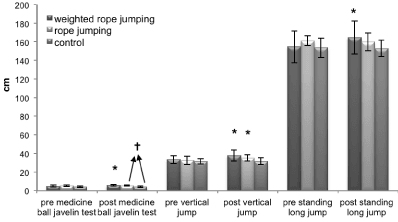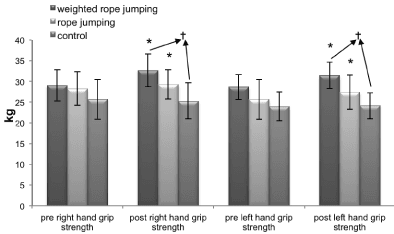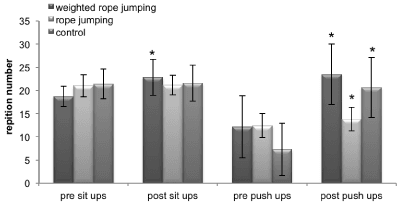Archives of Sports Medicine and Physiotherapy
Does the Weighted Rope Jump Training Affect the Motor Skills in Adolescent Female Volleyball Players?
Filiz Fatma Colakoglu1, Selma Karacan2, Nevin Atalay Guzel3 and Gul Baltaci4*
Cite this as
Colakoglu FF, Karacan S, Guzel NA, Baltaci G (2017) Does the Weighted Rope Jump Training Affect the Motor Skills in Adolescent Female Volleyball Players?. Arch Sports Med Physiother 2(1): 005-009. DOI: 10.17352/asmp.000004The aim of this study was to investigate the effect of a 12-week rope jumping and weighted rope jumping exercise programme on body composition and strength performance in 25 female adolescent volleyball players. Group 1 was trained on the weighted rope jumping (WRJ; (n=8)) diet as well as volleyball training, Group 2 on rope jumping (RJ; (n=9)) diet as well as volleyball training and Group 3, the control (C; (n=8)), participated only volleyball training. Percentage body fat and subsequent fat free mass by Sloan and Weir’s equation, the hand grip strength by Takei Grip -D trade mark hand dynamometer, sit-ups and push-ups for endurance and standing long jump, Sergeant Jump, and medicine ball javelin tests for lower and upper extremity muscular strength were applied before and after training. There was no difference in the body weight of the three groups although there was a considerable decrease of the body fat of WRJ and RJ groups (p<0,01).WRJ group was highly increased for the mean of sit-ups, standing long jump and the values of throwing the ball to the front part with two hands (p<0,01). There were significant differences in the values of push-up, right hand grip strength and the values of left hand grip strength in WRJ and C groups (p<0,01). In this study we showed that the muscles in upper extremity, lower extremity and abdominal region of a group doing exercises for 12-week programme with weighted rope would be gained a considerable power.
Introduction
The sports training potential of rope jumping has long been under estimated, and jumping has been used to its full potential in only few sports such as boxing, wrestling, tennis and martial arts [1-3]. Jumping rope has been burned some calories and built strength upper and lower body [4-6].
Rope jumping requires the coordination of several muscle groups to sustain the precisely timed and rhythmic movements that are integral to the exercise [2]. It is the coordination of these muscle groups that increases the athlete’s capacity for dynamic balance. When done properly, jump rope training can lead to dramatic improvements in sports performance [7]. Studies have illustrated the potential of rope jumping to utilize two anaerobic energy systems including ATP-PC and anaerobic glycolysis [8-10]. It can also be used develop coordination of neuromuscular skills, muscular strength, and cardiovascular endurance [11, 12]. The use of weighted ropes may carry additional advantages that are typically associated with core plyometrics [13]. Weighted ropes are commonly thought to help develop upper-body strength. Weighted-rope jumping is one such nontraditional exercise [14].
Jump rope training features hundreds of executions of the three phases of each jump. The load phase requires the body to be balanced on the balls of the feet with the knee flexed. The fight phase consists of those muscular contractions that propel the body high enough to clear the rope with each jump. In this phase it is consisted of propulsion and airborne phases. In the landing phase, athlete returns to the surface [13,14]. There is no study for investigating the effectiveness of weighted rope training on some different part of body strength parameters in the literature. The purpose of this investigation was to determine the 12 week rope jumping and weighted rope jumping exercises on female volleyball players’ some different part of body strength parameters and body composition.
Materials and Methods
Subjects
Twenty-five subjects were female, aged 13–16 years (age= χ±SD= 14.7 ± 1.2 yrs) and have played experienced-volleyball at least 2 years (Table 1). Physical and physiological performance tests were applied to all subjects at the laboratories and gymnasium of University. All subjects and their parents read and signed an institutionally approved informed consent form before the evaluations. The measurements were applied to the groups twice as a pre and post test. No differences all characteristics variables at the baseline of the study. This study was a randomized controlled trial using a 3 x 2 factorial design. The independent variables were measurement (before and after training) and group (trained [unweighted jump rope and weighted jump rope] and nontrained volleyball players). The dependent variables were performance tests normalized to body mass for each strength test.
Before the testing all subjects were educated regarding to particular requirements of the testing and providing appropriate warm-ups. They were classified into three homogenous groups: Group 1= weighted rope jump training group (WRJ, n=8), Group 2=rope jump training group (RJ, n=9) and Group 3=control group (C, n=8). Subjects in Group 2 were done rope jumping training with normal rope and technical training program for three times a week for twelve weeks. Group 1 was done same training program but they did with weighted rope. Control group also was done only technical training program for three days a week for twelve weeks. Rope training program are seen in Table 2.
Two different kinds of rope were used in this study. The rope training group used the cable rope (Selex) and the length of the rope, the part of the rope weight, and the total weight were 270cm, 100g and 160g; respectively. The weighted rope training group used the weighted rope (Power rope (V-3067)) and the length of the rope, the part of the rope weight and the total weight were 260cm, 600g and 695g; respectively.
Procedures
1. Body Composition: Body weight was measured to the nearest 0,1kg on a balance beam scale and body height was measured by using a stadiometer to the nearest 0.1cm with the subject standing, lightly clothed and without footwear. Skinfold thicknesses were taken at two sites (triceps and suprailiac for women) using Cliffon N.J. calipers. Percentage body fat and subsequent fat free mass were estimated using Sloan and Weir’s equation [3].
2. Strength: The hand grip strength of the subjects was measured by using Takei Grip–D trademark hand dynamometer. 30 seconds sit ups and push ups exercise were applied to the subjects. Standing long jump, sergeant jump, and medicine ball javelin tests were applied to the subjects as described before [15].
3. Medicine Ball Javelin Test: Face forward with the medicine ball hold overhead in two hands. Feet were be parallel and toeing the measuring line. Throw the ball for distance. A follow through step was allowed. Distance was measured from the front foot (on release) to where the ball lands. The best value of the three attempts was recorded [15].
4. Endurance: 30 seconds sit ups and push ups exercise were applied to the subjects. Lie on the mat with the knees bent, feet flat on the floor and the arms folded across the chest. Start each sit up with back on the floor. Raise yourself to the 90 degree position and then return to the flor. Recorded the number of sits up completed in 30 seconds. Lie on the mat, hands shoulder width apart & fully extend the arms. Lower the body until the elbows reach 90°. Return to the starting position with the arms fully extended. The feet were not to be held. The push up action was to be continuous with no rest. Complete as many push-ups as possible. Recorded the total number of full body push-ups [15].
For the standing long jump test, a tape measure was stuck on the floor, the participants stood on the line marked on the ground with feet slightly apart, and took-off and landed bending the knees to provide forward drive. This was repeated three times and the best value of the longest distance jumped was recorded [2,16].
For the vertical jump test, a tape measure was stuck on the wall, the participants stood upright with their side to the wall, keeping the feet flat on the ground reached up with the right hand. The point where the fingertips reached was marked, then they stood away from the wall, jumped vertically as high as possible using both arms and legs to assist in projecting the body upwards, and touched the wall at the highest point of the jump. The difference in distance between the reach height and the jump height determined the score. The best value of the three attempts was recorded [3].
Statistical analysis
Data indicating the effects of these exercise programs on subjects’ performance on the body composition and strength were analyzed with ANOVA and Kruskal-Wallis test. There are 3 groups and more dependent variables as pre and post-trainings.Therefore; it was used to MANOVA 2x 3 factoial design with related to more dependent variables in this study. With this method we had already tested to interaction pre- and post-trainings and among groups. The results are expressed as mean±standard deviation (SD). Statistical significance was set at p<0.05.
Results
There were no significant differences in body weight, height and performance tests at the baseline (p>0.05), (Table 1).
There was no significant difference in body weights and BMI among three groups. There was a significant decrease on body fat percentage of rope jumping and weighted rope jumping (F= 20.20, P<0.01). There was found a statistical effect on test value of percent body fat in repeated measures factors to study groups (rope jumping and weighted rope jumping) (F= 4.20, P<0.05), (Table 3).
There was a significant increase on vertical jump in weighted rope jumping and rope jumping groups after training (F= 17.11, P<0.01). There was found the common effects on vertical jumping of the experimental groups participating into different training programs (F=5.46, P<0.05). There was a significant increase on standing long jump values of weighted rope jumping groups (F= 4.78, P<0.05). There was found the common effects on standing long jump of the experimental groups participating into different training programs (F= 9.81, P<0.01), (Figure 1).
There was significant increase on test values to Medicine Ball Javelin of weighted rope jumping groups after training (F= 12.70, P<0.01), there was significant difference between control and rope jumping groups in comparison between groups (F= 4.22, P<0.05), (Figure 1).
It has been determined that there were significant common effects of repeated measures factor on the test groups which are subjected to different training programs on medicine ball javelin (F= 9.99, P<0.01), (Figure 1).
There was a significant difference on left hand strength between weighted rope jumping and control groups after training (F=6.60, P<0.05). And also there was a significant increase on left hand strength before and after training of experimental groups (F=9.03, P<0.05), (Figure 2).
There was significant increase on right hand strength values of both jumping groups after training (F= 9.42, P<0.05), there was significant difference between control and weighted rope jump training groups (F=3.98, P<0.05), and there was significant increase of common effects about right hand power of the experimental groups participating in to different training programs (F=6.87, P<0.05), (Figure 2).
There was a significant increase on sit ups values of weighted rope jump training group (F=5.34, P< 0.05). Figure 3 shows that significant common effects were determined about sit-ups values of the experimental groups participating to different training programs (F=4.64 P< 0.05). There was a significant increase on push up values of groups after training (F=4.59, P< 0.05), (Figure 3).
Discussion
This study showed that the muscles in upper extremity, lower extremity and abdominal region of a group doing exercises for 12-week programme with weighted rope would be gained a considerable power, muscular strength and reduction of body fat.
For years sports physiologists have touted the benefits of rope jumping, which can tone arm and leg muscles, trim body fat and improve coordination and endurance [7].
Bompa pointed out that a sportsman must be subjected to 8-12 training units so that he/she sufficient get beneficiency of his/her working. He also stated that a sportsman of the worldwide scale should work for 1000 hours, an international sportsman participating in international contest must work for 800 hours, national sportsman must work for 600 hours and a local sportsman must work for 400 so that they have efficiency [2].
One of the most important features of rope jumping is the muscle group used. Jumping rope use forearm, upper arm and shoulder muscles and also use different muscle of leg and hip muscle. Those who use techniques during rope jumping use more muscles. For example, the technique which involves the opening the legs to the sides works the adductor and abductor muscles in the legs while ropes jumping by making front traversing works the chest and upper back muscles (17). Jumping ropes do not strengthen people as much as a strengthening exercise by lifting does, but it gives the endurance and strength which is necessary to overcome the difficulties which may be faced during daily life [18,19]. Solis determined that rope jumping bring in tonus and strength which make muscles become good-looking [11, 20].
While the need to master jump rope technique may be seen as a limitation of the present testing approach, rope jumping is a common component of general conditioning methods and athletes become generally quickly proficient [21].
The increased muscle strength in hip and knee extensors found after 12 weeks exercise correlates well with the training programme that included of exercises for both hip and knee extensors [22]. Rope skipping seemed to be an effective exercise to improve muscle strength in these muscle groups. Improvement in knee extensors is especially important, as the knee joint is the most affected joint in adolescent’s volleyball players [23]. Earlier studies on groups of children and adolescents volleyball players [22,23]. show that this group is in inferior regarding functional ability, physical fitness and cardiovascular capacity compared to peers.
Tanikawa investigated the effect of 8-week rope jumping training program on the development of different knee biomechanics during jumping rope and turning activities in female recreational athletes. It was determined that the rope jumping increased the neuromuscular coordination at a meaningful level than male counterparts [17]. The exercise programme in our study was designed to meet the need for physical training, in accordance to the ACSM recommendation. The frequency of three times a week and the level of cardiovascular effort and weights were well tolerated. In this study we did not individualize the programme or increase the number of repetitions or the load during the training period, which might have given another outcome.
Masterson, et al., studied on effects of weighted rope jump training on upper extremity performance. They were evaluated upper extremity performance by bench press test and shown significantly improvements between pre-post treatment measurements [15].
Weighted rope training group was used the rope whose total is weighted 695g. Rhythmic and repeated movements might be inefficient for improved the suprapinatus muscle strength with this weightiness. In the present study, the 12-week training program induced a large increase in high-intensity jumping and throwing a javelin performance, which was associated with moderately-to-very large de- creases in muscular strength to the jump rope work- outs (Figure 1).
Another interesting finding of the present study is that both the magnitude of the training-induced changes in the different variables and the confidence (inferences) in these changes were affected by the method used to define the rope jumping.
Rope jumping is a particularly convenient exercise, since it can be performed in a restricted space and allows the testing of a large number of athletes simultaneously. In practice also, we recommend using the muscular strength of the measures as upper and lower extremities and abdomen. Further research involving athletes presenting with different training status (e.g., overreached or overtrained) is therefore still warranted. Finally, when using progressive statistics, the method employed to define the strength and body fatness may affect the outcomes.
Conclusion
In conclusion, it might be recommended that the progression of the training session should be evaluated according to the assessment of performance relating to the sporting activities done by each individual. It cannot be concluded whether rope jump training programs involving weighted ropes would be even more effective in volleyball players by increasing the strength levels. The rope appears feasible, given that this training method is not cost prohibitive and may increase the strength by giving the guidelines of exercise prescription for the functional performance of volleyball players.
- Pettersson U, Nordstrom P, Alfredson H, Henriksson LK, Lorentzon R (2000) Effect of high impact activity on bone mass and size in adolescent females: A comparative study between two different types of sports. Calcif Tissue Int 67: 207-214. Link: https://goo.gl/Q857Lh
- Bompa TO (1996) Theory and Methodology of Training: The Key to Athletic Performance by Kendall/Hunt Publishing Company. Link: https://goo.gl/aWdnVg
- Tse AC, Fong SS, Wong TW, Masters R (2017) Analogy motor learning by young children: a study of rope skipping. Eur J Sport Sci 17: 152-159. Link: https://goo.gl/hWiJcY
- Ha AS, Burnett A, Sum R, Medic N, Ng JY (2015) Outcomes of the Rope Skipping 'STAR' Programme for Schoolchildren. J Hum Kinet 45: 233-240. Link: https://goo.gl/NCwa38
- Town GP, Sol N, Sinning WE (1980) the effect of rope skipping rate on energy expenditure of males and females. Med Sci Sports Exerc 12: 295-298. Link: https://goo.gl/pr5wiE
- Jetto M, Mongeon J, Routhier R (1979) the energy cost of rope skipping. J Sports Med Phys Fitness 19: 33-37. Link: https://goo.gl/ohyBWh
- Harrell JS, McMurray RG, Baggett CD, Pennell ML, Pearce PF, et al. (2005) Energy costs of physical activities in children and adolescents. Med Sci Sports Exerc 37: 329-336. Link: https://goo.gl/18Zihu
- Lee, B (2003) Jump Rope Training: Human Kinetics.
- Town GP, Sole N, Sinning WE (1980) The effect of rope skipping rate on energy expenditure of males and females. Med Sci Sports Exerc 12: 295-298. Link: https://goo.gl/0v9xbC
- Quirk JE, Sinning WE (1982) Anaerobic and aerobic responses of males and females to rope skipping. Med Sci Sports Exerc 14: 26-29. Link: https://goo.gl/5kYO94
- Solis K, Foster C, Thompson N, Cefalu C (1988) Aerobic requirements for and hearth rate responses to variations in rope jumping techniques. Phys Sportsmed 16: 121-128. Link: https://goo.gl/FJnG57
- Ham OK, Sung KM, Lee BG, Choi HW, Im EO (2016) Transtheoretical Model Based Exercise Counseling Combined with Music Skipping Rope Exercise on Childhood Obesity. Asian Nurs Res 10: 116-122. Link: https://goo.gl/Dx5NYI
- Orhan S (2013) The effects of rope training on heart rate, anaerobic power and reaction time of the basketball players. Life Sci J 10: 266-271. Link: https://goo.gl/So2Nev
- Buchheit M, Rabbani A, Beigi HT (2014) Predicting changes in high-intensity intermittent running performance with acute responses to short jump rope workouts in children. J Sports Sci Med 13: 476-482. Link: https://goo.gl/M3H2AH
- MacKenzie B (2005) 101 Performance Evaluation Tests. Electric Word Plc: London. Link: https://goo.gl/3Ma2Dd
- Masterson GL, Brown S (1993) Effects of weighted rope jump training on power performance test in collegians. J Strength and Cond Res 7: 108-114. Link: https://goo.gl/m0hiQ1
- Tanikawa H, Matsumoto H, Harato K, Kiriyama Y, Suda Y, et al. (2014) Female recreational athletes demonstrate different knee biomechanics from male counterparts during jumping rope and turning activities. J Orthop Sci 19: 104-111. Link: https://goo.gl/64Aqpj
- Ghorbani F, Heidarimoghadam R, Karami M, Fathi K, Minasian V, et al. (2014) The effect of six-week aerobic training program on cardiovascular fitness, body composition and mental health among female students. J Res Health Sci 14: 264-267. Link: https://goo.gl/h09pa4
- Ha AS, Lonsdale C, Ng JY, Lubans DR (2014) A school-based rope skipping intervention for adolescents in Hong Kong: protocol of a matched-pair cluster randomized controlled trial. BMC Public Health. Link: https://goo.gl/NLCBEB
- Solis KM (1992) Ropics: The next jump forward in fitness. Leisure Press Champaign, Illionis.
- Miyaguchi K, Sugiura H, Demura S (2014) Possibility of stretch-shortening cycle movement training using a jump rope. J Strength Cond Res 28: 700-705. Link: https://goo.gl/HqgCr8
- Ozer D, Duzgun I, Baltaci G, Karacan S, Colakoglu F (2011) The effects of rope or weighted rope jump training on strength, coordination and proprioception in adolescent female volleyball players. J Sports Med Phys Fitness 51: 211-219. Link: https://goo.gl/JWGSx9
- Duzgun I, Baltaci G, Colakoglu F, Tunay VB, Ozer D (2010) The effects of jump-rope training on shoulder isokinetic strength in adolescent volleyball players. J Sport Rehabil 19: 184-199. Link: https://goo.gl/JsLmAI
Article Alerts
Subscribe to our articles alerts and stay tuned.
 This work is licensed under a Creative Commons Attribution 4.0 International License.
This work is licensed under a Creative Commons Attribution 4.0 International License.




 Save to Mendeley
Save to Mendeley
